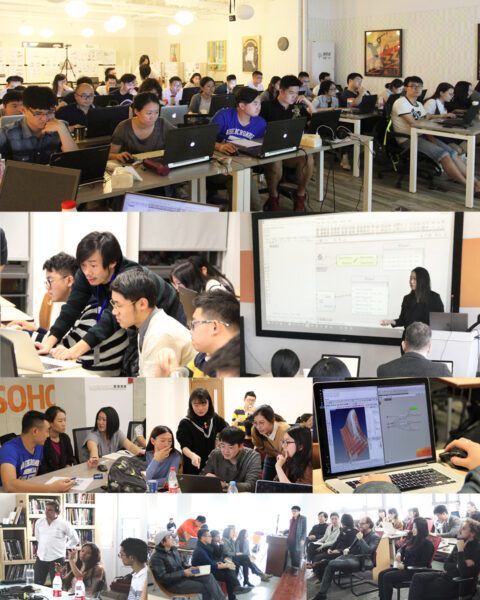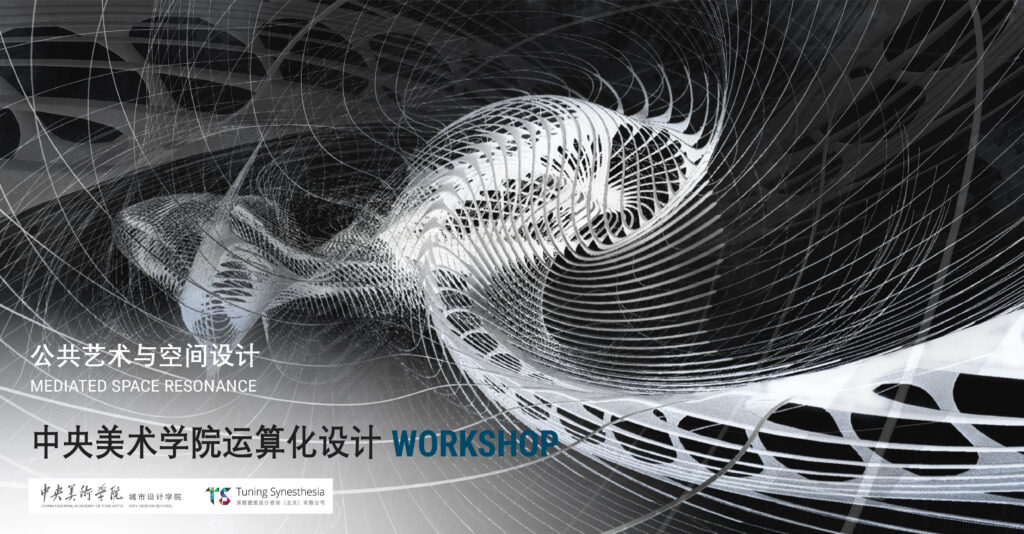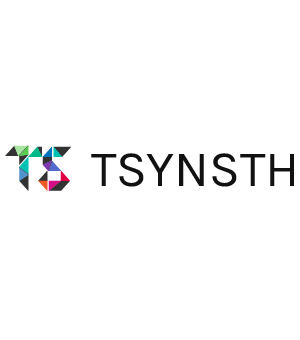CAFA Computational Design Workshop 2018
CAFA Computational Design Workshop 2018
We are excited to announce the launch of registration for our new computational design workshop in collaboration with Central Academy of Art in Beijing.
The design studio is this time the most focused, targeting art and spatial design, we explore the intersection between artistic abstraction and algorithmic/generative expression. We expect it to be much fun and hope many students can join and explode creativity together.

2018中央美术学院运算化设计工作营
CAFA Computational Design Workshop 2018 Mediated Space Resonance | Public Art and Space Design, City Design School
A Course: From 2018.12.15 13 days
B Course: From 2018.12.27 11 days;
@Central Academy of Art(燕郊校区)
12800CNY (including accommodation)
Early-bird price 9800CNY (for registration before 12.08)
近年来,在全球智慧城市的加速发展进程中,中国已经成为领先国家之一。从无现金支付到实时交通信号监管分析,社会基础设施发生质的飞跃。在城市发展过程中,公共“界面”如何应对急剧变化的社会结构?
这是一个为期11-13天的运算化设计工作营,其中亮点是通过算法设计和数字化原型来探索(技术方面的)空间的可能性的设计课程,以公共艺术和空间设计为目标,并将其作为人、社会和技术之间的沟通的媒介。并与由新兴/感知技术发展而来的新工艺、新方法、新艺术和新设计理念紧密结合,重点放在集成性和创新性。追求艺术,使我们生活空间形态丰富多彩。本工作营通过对数字化技术在设计中的应用,完成收集、分析、映射信息和相关的空间网络教学, 实现创建因地制宜的交互艺术与设计原型。这些原型可以通过时间预测空间演变的多样性,并复杂化网络连接和场域空间,同时具有无限生长和变化的新兴行为模式。
The overall number of “smart city” plans has increased across the globe in recent years, especially in China, which is one of the leading countries when it comes to the accelerated development of such projects. From cashless payment options to the regulation of traffic signals through real-time analysis, we are witnessing a period of radical change in our social-economic infrastructure. Someday soon, cities will be transformed into smart machines. In these sentient urban areas, what model of public interface can best response to the radical shifts taking place in social spaces?
This 11 to 13 day workshop explores what is possible within spaces mediated by technology through computational design and digital prototyping, targeting public art and spatial design as a socio-technological interface that connects people, society, and technology. A strong emphasis is placed on creative and generative ideas that closely integrate with new process, methodologies, and conceptualizations of art and design that have been evolved thanks to the logic of emergent sentient technologies. Starting with the premise that art is an experience-based, transformative force that connects us to the space around us in our everyday lives, the agenda and outcomes of this workshop will focus on using the integration of algorithmic and generative design to collect, analyse, and map information and relevant spatial networks, in order to create site-specific interactive art and design prototypes. These prototypes will be generated for the purpose of variable performance across time, complex networks of communication, and field spaces with emergent behavioural patterns of growth and change.
Our workshop consists of four stages: Software Tutorials of Rhino, Software Tutorials of Grasshopper, Computational Design Fundamentals, and Design Studio.
工作营概要
Workshop Structure
工作营分为四个阶段:Rhino软件,Grasshopper插件,运算化设计基础,公共艺术与空间设计课
考虑学生未来学术与职业生涯的发展,课程量身定制了各个阶段,学生将循序渐进的步入运算化领域,并从理论与实践两个方面来学习运算化设计。
阶段1和2是一个短期高效的软件学习过程(Rhino和GH);阶段3讲授运算设计基础,学生可以掌握运算化算法和生成式设计的核心;阶段4学生自行思考设计课题,通过与跨学科导师进行开放讨论,把阶段1~3所学内容应用于项目。
*工作营分A班与B班,学生根据时间来选择。
*对于想要选择B班且不熟悉Rhino软件的同学,我们可以为学生提供一些简单的课前辅导(更多详情请联系老师进行咨询)。
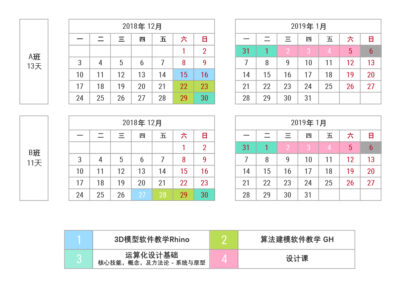
阶段1 及2软件教学 Rhino 与 GH – 3D建模与算法建模
Stage 1 and 2 Software Tutorials of Rhino and GH – 3D Modeling and Algorithmic Modeling
第1和2阶段介绍Rhino主要命令和Grasshopper电池块组件,以及世界著名项目的建模方法,掌握两个软件从基础到中级的建模技能。学生们将习得最为常用的建模知识,包括implict和explict建模方法。
课题: Nurbs曲面与多边形网格面,单/双曲面,参数/算法建模,以及GH插件:Lunchbox和Weavebird。
Stage 1 and 2 feature essential commands (Rhino) and components (GH), as well as modelling of world-renowned projects, which provide students with a basic to intermediate understanding of modelling using Rhino and GH. During these stages, students will acquire some of the most useful skills and important knowledge for both implicit and explicit modelling.
Key Topics: Nurbs surface vs. polygon mesh, single/double curved surfaces, parametric / algorithmic modeling with examples, and GH addons: Lunchbox and Weaverbird.
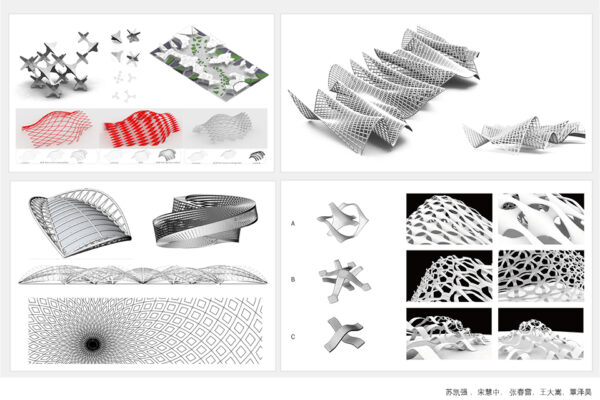
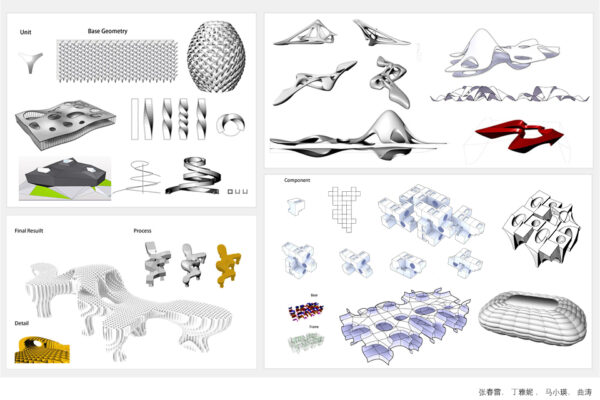
阶段3 运算化设计基础 – 核心技能,概念及方法论
Computational Design Fundamentals – Core Skills, Concepts, and Methodologies
第三阶段通过运算化设计在数字化技能与学科之间搭建桥梁,涉及一系列讲座、GH各类插件输入和输出方法的教学以及课堂练习。变量与应用系统是系联设计的学术核心,在此框架下着重介绍常用算法和生成过程,研究重点为系统应用于数字原型,以此挖掘新的设计策略和方案。
系统的定义是“部分构成的整体”,它存在于从自然到文化再到人类社会的不同领域和组织中。尤其当部分间相互作用产生新属性时,涌现特性就此产生。
“整体大于部分之和”——亚里士多德
课题:算法与生成式设计;系统与数字原型;场域、网络、泰森多边形、随机、递归、Multi-Agent Base、variations and selection;设计构思;涌现特性;自适应系统;GH插件:Kangaroo、Ladybug、Butterfly、Galapagos、Hoopsnake 、Quelea,Z-Brush软件等(根据设计课需求选择其中几个)。
Stage 3 intends to bridge the gap between the student’s existing digital skills and the disciplinary side of computational design through a series of lectures, interactive exercises, and input and output methodology tutorials using selected Grasshopper add-ons and custom coding components. The main focus is placed on an introduction of frequently used algorithms and generative processes under a Variation of Applied System (VAS) framework. VAS is an academic core of Tuning Synesthesia that focuses on researching system* applications for the purpose of digital prototyping and discovering new digital design strategies and schemes.
*A system may be defined as a set of components that shape a whole and can be found in various fields of matter and organization, ranging from nature to culture and society, among others. Particularly, emergent properties arise when the interaction of individual component produce new functions.
“The whole is greater than the sum of its parts.” – Aristotle
Key Topics: Algorithmic Design; Generative Design; System and Digital Prototyping; Field, Network, Voronoi, Stochastic, Recursion, Multi-Agent Base; variations and selection; design scheme; emergent; self-organized system; GH custom components and add-ons, selected from the following list: Kangaroo, Ladybug, Butterfly, Galapagos, and Hoopsnake or Quelea; Z-Brush.
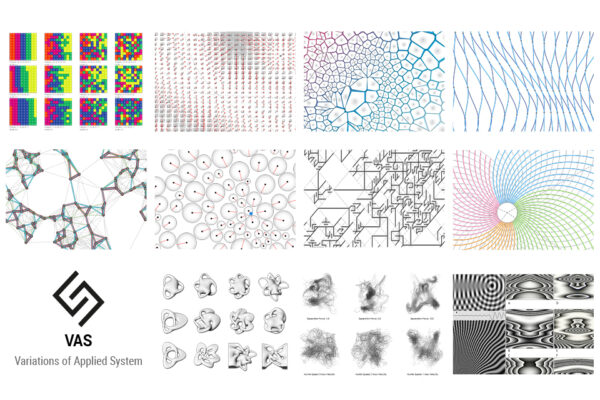
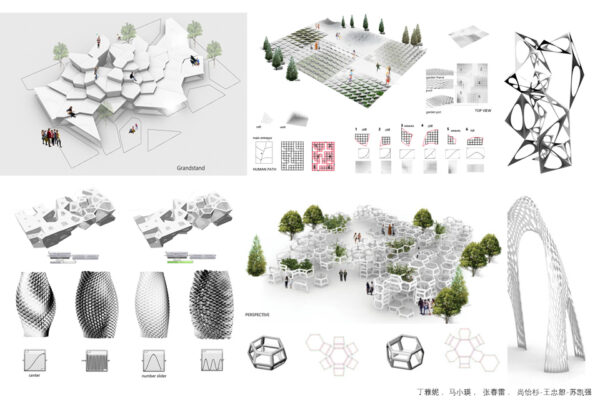
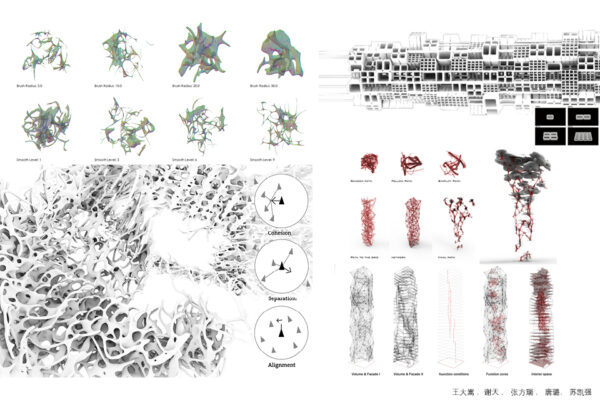
阶段4 设计课:应用技能与知识,公共艺术与空间设计
Design Studio
第四阶段注重理论与实践相结合,根据工作营的主题“Mediated Space of Resonance”来进行公共艺术与空间设计。通过接触运算化设计应用于项目,学生可以提升技能与扩展相关知识。在项目特定场域条件下,探索处理复杂系统的方法。学生最终成果包括分析图、渲染图及3D打印模型等。
课题以中央美术学院实际项目北京大兴国际机场(by ZAHA)为背景,学生以竞赛方式参与大型知名项目,创作出具有中国特色的空间形象。优秀作品将有机会得到进一步深化及实施,入选2019年中央美术学院毕业展。
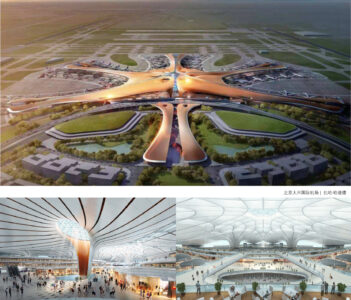
课题:设计应用; Mediated Space of Resonance;复杂系统;3 d打印;机场调研;公共艺术;空间设计; 交互界面;临时构筑物; 主题景观; 场域特定艺术。
Stage 4 is an integration of practice and academic exploration in the fields of public art and space design for the purpose of creating Mediated Space Resonance. By applying their current computational design knowledge during the creation of a project, students will have the chance to extend their skills to a more advanced level. The Design Studio is a means of exploring ways to handle complex systems within site-specific conditions found in projects located throughout China. By the end of studio, students will create outstanding portfolios that include design expression in multiple formats: diagrams, renderings, and physical models generated by 3D printers (which are available at CAFA).
Most importantly, the assignment is set in the context of an existing project currently being run by the CAFA City Design School at Beijing Daxing International Airport, designed by Zaha Hadid. The Design Studio is an essential opportunity for students who are keen to be part of the development of renowned projects and who wish to explore and create designs that represent Chinese culture. Outstanding students will either be selected to help develop future projects or their project may be selected for the CAFA graduation exhibition in 2019.
Key Topics: Application; Mediated Space Resonance; Complex system; 3D print; Research of International Airport; Public Art; Space Design; Interactive Interface; Temporary structure; Theme-based landscape; Site-Specific Art;
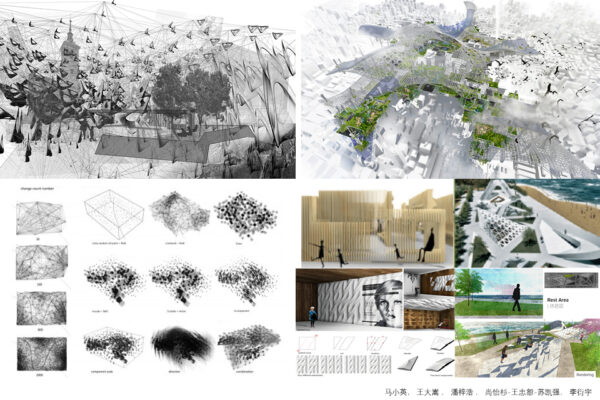
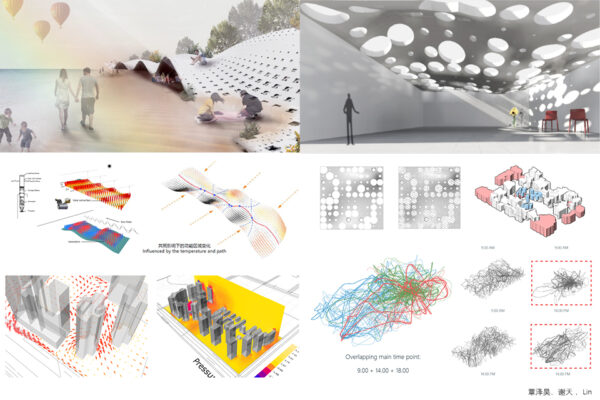
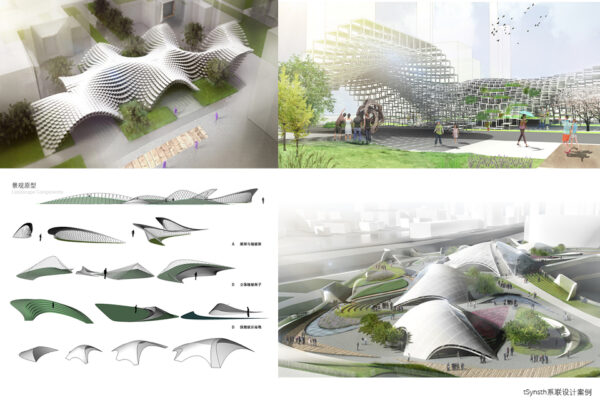
工作营导师
Workshop Director

运算化设计导师:冬木千枝(Chie Fuyuki)
tSynsth系联设计创始人;纽约普瑞特艺术学院(Pratt Institute)建筑学硕士;东京立教大学文学学士;曾就职于纽约Lindy Roy事务所、MAD事务所;于2017年起担任土人学社运算化设计工作坊主导师;曾于2016-2017年分别与谷德、非静止建筑、匠人营国合作举办了5季tSynsth运算化设计“变量与应用系统”研究坊。目前对跨学科系统与数字化设计原型进行专项研究,涉及建筑学、计算机科学、自然科学、文学、艺术和音乐等,并延伸至科技、创新设计及运算化应用。

公共艺术与空间设计导师:松尾光伸(MATSUO Mitsunobu)
雕塑家、环境造型家、中央美术学院教授、日本NPO福利艺术文化研究会理事长、亚洲基础造形联合学会前事务局局长、中国雕塑学会顾问。松尾光伸先生创造了“INFORMART-信息造型”的新造型概念。该概念是指利用一个多面体单元所具有的组合信息功能,通过单元的自由组合可以构成多达几十万种各异的形态。

公共艺术与空间设计导师:潘鹏(PAN Peng)
城市设计专家、建筑师、高级工程师;清华大学文学学士;香港理工大学设计学硕士;现任中央美术学院城市设计与创新研究院设计总监。社会兼职:中国城市发展研究会文化和旅游工作委员会执行委员;创意中国设计联盟秘书长;中国青年设计师驻场计划执行秘书长;北科国际城市设计学院执行院长。以“新型城镇化建设创意设计”、“艺术引领城市设计”为主要研究方向。曾主持北京升平颐和会议中心规划设计、中信国安神州半岛康养小镇规划设计、洛阳易经小镇(龙马负图寺)规划设计等文化旅游开发项目。
嘉宾及评委
Lecturers
为加速学生对当代设计和技术的深度理解,工作营将邀请中央美术学院的学者和艺术与设计领域的专家进行专题讲座,点评学生的最终成果。
The workshop features a series of lectures and professional feedback sessions during the design phase, which will be hosted by CAFA academics and experts in the design and art fields. These lectures aim to help accelerate the learning process, while increasing students’ depth of knowledge in contemporary design and technologies, as well as the methodologies driving their design outcomes.
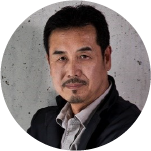
学术主持:王中(WANG Zhong)
中央美术学院教授、中央美术学院城市设计学院院长、中国公共艺术研究中心主任、北京市人民政府专家顾问团顾问、中国城市雕塑家协会副主席、中国雕塑学会常务理事、国际动态艺术组织艺术委员;曾荣获中国环境艺术杰出贡献奖、新中国城市雕塑60年建设成就奖、晶麒麟生活艺术家等重要艺术奖项。作为中央美术学院公共艺术学科带头人,王中教授十余年来致力于国内外公共艺术领域的研究工作,2000年在中央美术学院雕塑系创办中国第一个公共艺术本科教学工作室,2005年在中央美术学院城市设计学院创办公共艺术系。2007年主持建设部“中外城市公共艺术投资政策对比研究”课题,2008年受聘第二十九届北京奥林匹克运动会开幕式策划工作,荣获北京2008奥组委颁发“工作荣誉奖”,2009年主持上海世博园区公共艺术设计,2011年至2015年主持北京地铁8、9、14、15、16号线公共艺术项目,2015年主持北京CBD核心区公共空间艺术整体规划设计,2016年主持青岛轨道交通13号线空间一体化设计,开创AUD系统设计理念(艺术引导城市设计Art oriented Urban Design),主持文化部“公共艺术在新兴城镇化发展中作用研究”课题,2016年中国公共艺术展总策展召集人,2016年主持北京新机场公共艺术规划。

Martin Miller 马丁 · 米勒 (美国)
非静止建筑设计设计(AntiStatics Architecture)总监、合伙人、美国康奈尔大学建筑学院实践教授、美国宾夕法尼亚大学建筑硕士
郑默 Mo Zheng
北京非静止建筑设计(AntiStatics Architecture)总经理及合伙人、美国宾夕法尼亚大学建筑硕士

张梦瑶 Mengyao Zhang
系联设计研究人员、米兰理工大学硕士、清华大学建筑学学士、梦想加空间产品经理,曾担任Thinkwell 视觉与内容设计师、北京市建筑设计研究院(BIAD)建筑师
助教团队
Assistants
覃立超 (LICHAO QIN) 系联设计合伙人,高级设计师;广西大学建筑学学士;曾就职于MAD事务所,度态建筑,清华大学建筑设计研究院,悉地国际
王大嵩(DASONG WANG) 墨尔本皇家理工大学建筑学硕士,即将攻读博士学位;德国维斯马大学建筑学硕士;曾经就职于Penda建筑事务所
谢天(TIAN XIE) 墨尔本皇家理工大学建筑学硕士;四川大学锦城学院建筑学学士;曾就职于前湖南省设计院建筑六所,华诚博远工程技术集团
尚子敬(ZIJING SHANG) 系联设计初级建筑设计师;宾夕法尼亚州立大学建筑学硕士;北京工业大学环境艺术系室内设计专业学士
王晨阳(CHENYANG WANG) 系联设计建筑实习生;清华美术学院环境艺术系在读研究生;鲁迅美术学院环境艺术系艺术学学士
报名须知
Registration
| 上课时间与地点 | A班: 2018.12.15 开始 13天 B班: 2018.12.27 开始 11天 中央美术学院城市设计学院(燕郊校区) |
| 学费 | 包含住宿11800元,12月8日前报名享受早鸟价:9800元 |
| 课程收获 | 11-13 天的运算化设计学习 中央美术学院的结业证书 免费校内住宿(A班16与23号周日除外),体验央美校内学习环境,并参与在校生设计课题 优秀作品将入选2019年中央美术学院毕业展 嘉宾讲座 工作推荐 资源:3D打印设备 |
| 报名方式 | 请将姓名、联系方式、联系邮箱:cafa_edu@163.com。 |
| 联系方式 | 电话 :(周一至周五:上午9点半-下午5点半) 邮件: cafa_edu@163.com 联系人:潘琳13701310467;陈潇13910203345。 |
| 注意事项 | 学生需自备笔记本电脑,必须使用Windows系统,请预先下安装最新版本Rhinoceros 6软件。电脑基本配置参考:CPU i7,内存 8g,独立显卡 1g以上。 除免费住宿外,学生需要自付旅途的各项开支及旅行保险。 |
紧凑的学习安排,精锐的教师团队,
用心打造的针对性课程,不胜枚举的干货和福利……
在2018年溜走前的12月份,希望与你们相遇。
